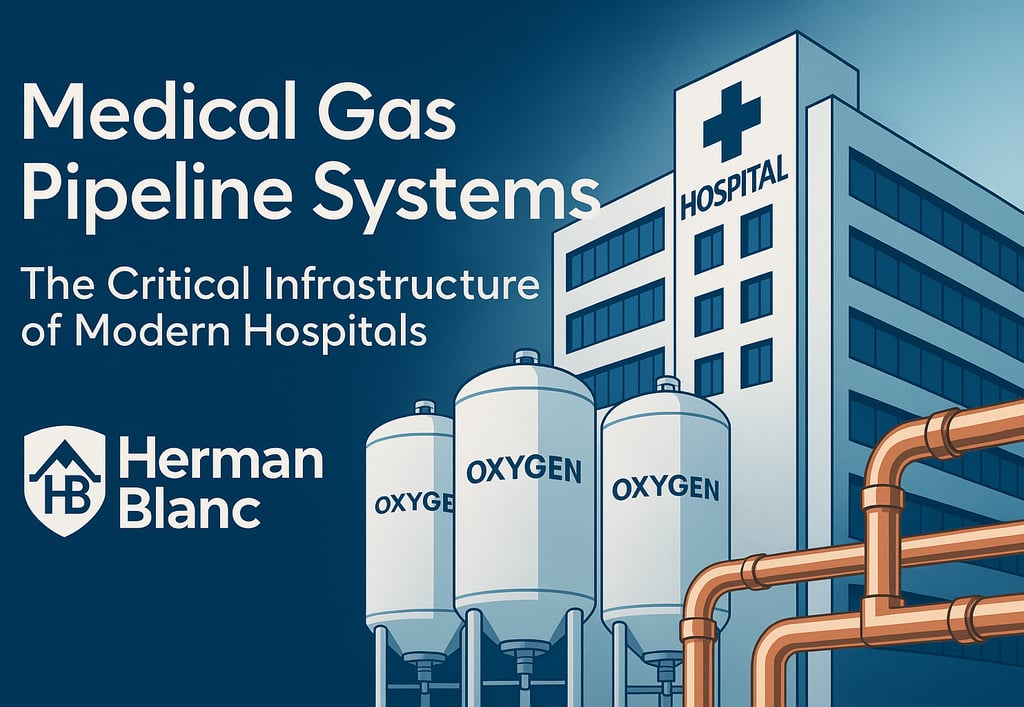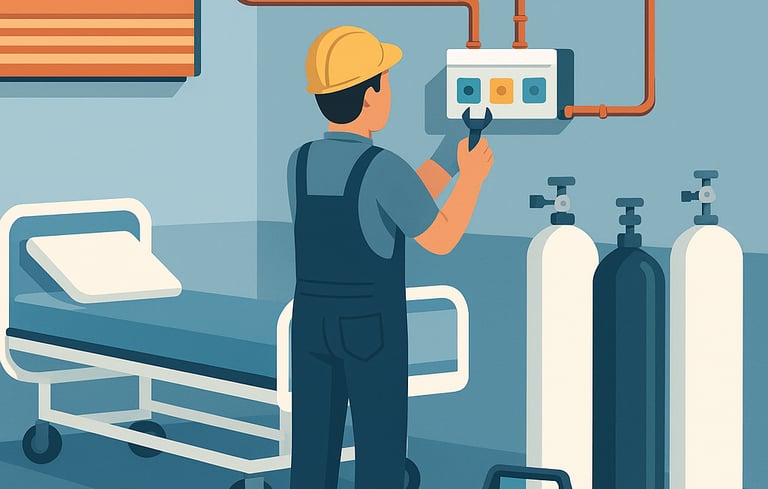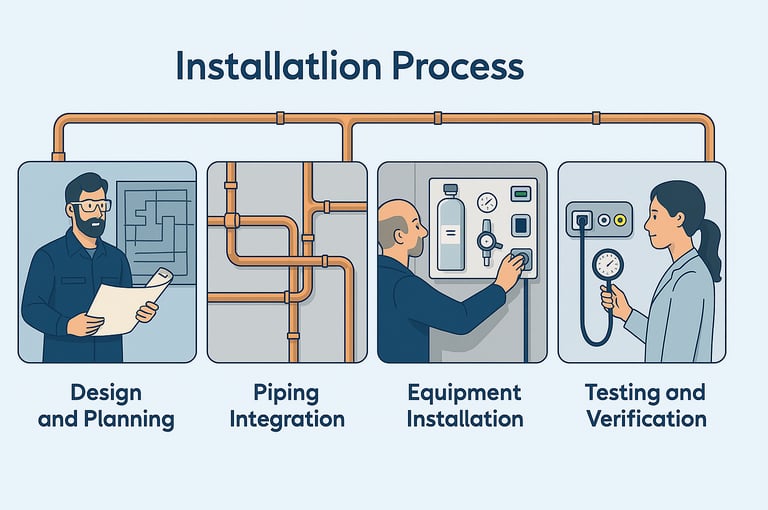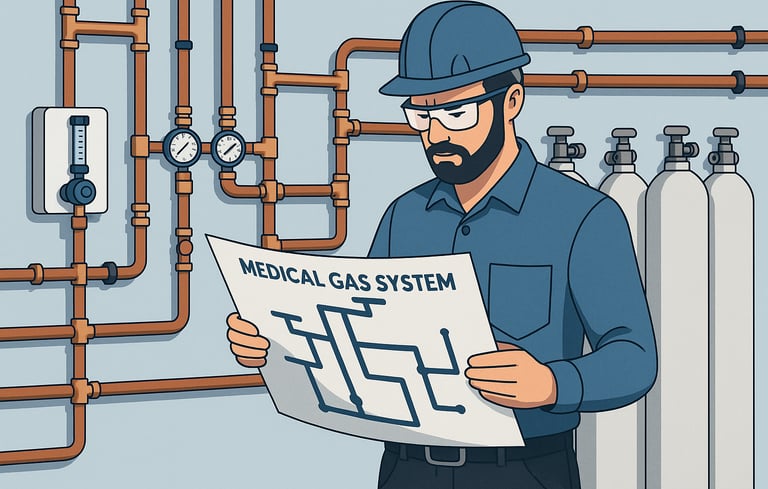Medical Gas Pipeline Systems:
The Critical Infrastructure of Modern Hospitals / Medical Gas Systems And Medical Gas Equipment


Medical Gas Pipeline Systems: The Critical Infrastructure of Modern Hospitals
Modern hospitals are highly complex facilities where every detail can directly affect patient safety and clinical efficiency. Among the invisible systems that form the backbone of hospital infrastructure, none is more critical than the Medical Gas Pipeline System (MGPS).
From intensive care units and emergency rooms to operating theaters, a reliable gas supply is essential for life-saving treatment. Unlike medical equipment, which is purchased toward the end of construction, medical gas systems must be integrated at the earliest stages of hospital construction. They are not just devices, but mechanical engineering systems that require precision design, specialized installation, and strict compliance with international standards.
Why Are Medical Gas Systems Essential?
Medical gas systems supply life-supporting gases such as:
Oxygen (O₂): Life-supporting therapy for critical care and surgical procedures.
Medical Air (MA): Used in ventilators, anesthesia, and driving surgical tools.
Vacuum (VAC): Essential for suction in surgeries and patient care.
Nitrous Oxide (N₂O): Widely used in anesthesia.
Nitrogen (N₂): Supplies energy to operating tools.
Carbon Dioxide (CO₂): Used in endoscopy, laparoscopic surgery, and medical research.
The MGPS ensures continuous supply at controlled pressure, quality, and flow rates, connecting source equipment (oxygen generators, manifolds, vacuum pumps) to terminal outlets at patient bedsides, ICUs, and operating theaters.
The Key Difference: Medical Devices vs. Medical Gas Systems
Hospital investors often confuse medical devices with medical infrastructure. The difference is fundamental:
Medical Devices (MRI, ventilators, monitors, surgical tables): Procured toward the end of hospital construction, standalone items.
Medical Gas Pipeline Systems: Must be designed and installed during the structural and mechanical phases of construction.
This is because pipelines run through walls, ceilings, and floors. Retrofitting or modifying them after construction is extremely expensive, time-consuming, and often not feasible.
Core Components of a Medical Gas Pipeline System
A professional MGPS installation includes:
Source Equipment:
Oxygen plants or bulk storage tanks
Manifolds and automatic switch-over systems
Vacuum pumps and medical air compressors
Pipeline Network:
Copper pipes installed using certified brazing methods
Correct sizing and pressure balancing
Proper labeling and zoning
Control & Monitoring:
Area Valve Service Units (AVSUs)
Pressure regulators
Alarms and monitoring panels
Terminal Outlets:
Outlets installed at patient care areas
ICU, NICU, emergency rooms, operating theaters
Safety Systems:
Pressure relief valves
Non-return valves
Alarm and emergency shut-off mechanisms
Installation and Engineering Process
A successful medical gas installation follows several technical stages:
Feasibility & Design:
Demand calculation (liters per minute for each gas).
Pipeline route drawings integrated with hospital architectural plans.
Compliance with HTM 02-01, NFPA 99, ISO 7396.
Procurement & Materials:
High-quality, seamless copper pipes.
Certified valves, outlets, and components.
Oxygen generators and vacuum equipment.
Installation:
Specialized brazing with silver-based filler materials.
Clean-room welding to avoid contamination.
Strict adherence to pressure zoning.
Testing & Commissioning:
Pressure and leakage testing.
Flow validation under load.
Alarm system verification.
Full compliance certification.
Training & Maintenance:
Hands-on training for hospital technical staff.
Preventive maintenance programs.
International Standards and Compliance
Patient safety relies on strict compliance with international guidelines:
HTM 02-01 (UK): Comprehensive standard for MGPS design and installation.
NFPA 99 (USA): Health Care Facilities Code for medical gas and vacuum systems.
ISO 7396 (International): Standards for design, installation, and operation of MGPS.
Local Health Ministry Requirements: Essential for licensing and accreditation.
Non-compliance can delay hospital opening, lead to legal penalties, or worse—endanger patient lives.
Why Timing Is Critical
Early integration during construction avoids costly retrofits.
Proper pipeline placement defines ICU, OR, and ward layouts.
Delayed or incorrect installation risks regulatory rejection of hospital licenses.
Therefore, medical gas systems should be prioritized alongside HVAC, plumbing, and electrical systems—never left until the end.
Why Choose Herman Blanc?
At Herman Blanc, we combine healthcare expertise with engineering precision to deliver safe, reliable, and internationally compliant MGPS solutions.
Global Experience: Hospital projects completed in Europe, Africa, and the Middle East.
Turnkey Solutions: From feasibility and design to installation, testing, and certification.
International Compliance: Projects fully aligned with HTM, NFPA, ISO, and local regulations.
High-Quality Materials: Only certified copper pipes and medical-grade components.
Proven Reliability: Systems designed for efficiency, safety, and long-term durability.
Conclusion
A medical gas pipeline system is not just another piece of equipment—it is the foundation of modern hospital safety and functionality. Installed too late, it can cause massive costs and delays. Installed incorrectly, it risks patient lives.
That is why hospital investors, contractors, and healthcare providers must treat MGPS as a priority infrastructure investment.
At Herman Blanc, we deliver perfectionist turnkey medical gas systems—engineered, installed, and certified to the world’s highest standards. With our expertise, your hospital will be safe, efficient, and future-ready.
Contact us today to learn more about our medical gas pipeline systems and how we can support your hospital projects worldwide.
Contact With Us






